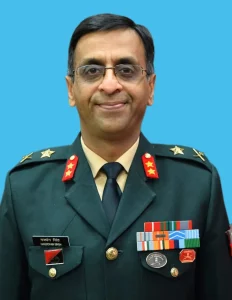In Defence Current Affairs for Monthly DCA March 2025, we will see the latest national and international current affairs news. These important current affairs will be beneficial for your upcoming NDA, CDS, CDS OTA, AFCAT, TA, Agniveer Army, Agniveer Navy, Agniveer Air Force, Women Military Police, INET, MNS, ACC exams, SCO, PCSL, CAPF, and SSB interviews, and direct entries for Army, Navy, and Air Force like SSC Tech, TGC, JAG, NCC, TES, 10+2 Cadet. Download a PDF file about current events at the end of this article. Let us now see the Daily Defence Current Affairs.
Monthly Defence Current Affairs March 2025
Exercise Desert Hunt 2025
- An integrated Tri-Service Special Forces exercise named Exercise Desert Hunt 2025 was conducted by the Indian Air Force at Air Force Station Jodhpur from 24 to 28 February 2025.
- The exercise involved elite Para SF from the Indian Army, the Marine Commandos from the Indian Navy along with the Garud from the Indian Air Force, participating together in a simulated combat environment.
- This high-intensity drill was aimed at enhancing interoperability, coordination and synergy among the three Special Forces units to ensure swift and effective response towards emerging security challenges.
DRDO Unveils BM-04 SRBM
- DRDO recently unveiled a mock-up of the BM-04 missile at the ‘Vigyan Vaibhav’ defence exhibition in Hyderabad.
- Described as a Short-Range Ballistic Missile (SRBM), the BM-04 is designed to counter enemy anti-access/area denial (A2/AD) capabilities, which are strategic systems used by adversaries like China and Pakistan to restrict operational freedom in contested zones.
- The BM-04 incorporates a Common Hypersonic Glide Body (C-HGB) atop a two-stage booster, suggesting it may achieve speeds exceeding Mach 5, blending ballistic reach with hypersonic agility. This configuration allows for low-altitude, unpredictable flight paths that can evade radar and missile defences, making it ideal for penetrating A2/AD systems.
- The BM-04 has a range of 400-1500 km, which places it within the short to medium-range category, though it is officially classified as a Short-Range Ballistic Missile (SRBM).
- It uses two-stage solid propulsion, which provides reliability and quick response times. The BM-04 using inertial navigation system and satellite navigation as its guidance system.

India Becomes A Hypersonic Power
- India has marked a significant milestone in its military capabilities by unveiling its latest advancements in hypersonic technology. The DRDO showcased a Hypersonic Glide Vehicle (HGV) and a Transporter Erector Launcher (TEL) as part of the Long-Range Anti-Ship Missile (LR-ASHM) program.
- This development positions India as a hypersonic power, alongside nations like the United States, China, and Russia, which have also made significant strides in this field.
- Hypersonic missiles, capable of travelling at speeds greater than Mach 5 (approximately 3,800 mph or 6,100 km/h), represent a significant advancement in military technology.
- Hypersonic Glide Vehicle (HGV) plays a critical role, particularly in the Long Range Anti-Ship Missile (LR-ASHM) program. The HGV is designed to travel at speeds exceeding Mach 5, positioning it as a potent tool in India’s anti-ship warfare strategy.
- The successful test of India’s long-range hypersonic missile, capable of carrying both conventional and nuclear payloads over distances exceeding 1,500 km, underscores the country’s growing technical prowess in advanced missile development.

PM Modi To Soon Lay Foundation Stone For New Missile Testing Range
- At a time when the Indian defence researchers are developing a large number of tactical missile systems, the Cabinet Committee on Security (CCS) has given approval in Oct 2024, for setting up a new missiles testing range in Andhra Pradesh valued at ₹20,000.
- The proposal was cleared by the CCS headed by Prime Minister Narendra Modi as per which the new missile range will come up in the Nagayalanka area of Andhra Pradesh.
- This facility is intended to enhance India’s defence capabilities by providing a site for testing tactical missile systems, including surface-to-air and anti-tank missiles, as well as other projects developed by the DRDO.
- The approval of this new range is part of broader efforts to strengthen India’s defence infrastructure. The CCS has also cleared other significant proposals, such as the procurement of 31 Predator drones from the U.S. and the construction of two nuclear submarines under Project ATV.
Solar Industries Bags Order For The Supply of Hand Grenades
- Solar Industries India Limited, through its wholly-owned subsidiary Solar Defence and Aerospace Limited, has secured a significant contract worth ₹239 crore from the Ministry of Defence, Government of India.
- This contract involves the supply of multi-mode hand grenades, which are to be delivered over a period of one year. The deal reinforces Solar Industries’ strong position in the defence manufacturing sector, contributing to India’s self-reliance in defence production and enhancing national security capabilities.
- Contract Value: ₹239 crore
- Product: Multi-Mode Hand Grenades
- Delivery Period: One Year
- Entity Awarding the Contract: Ministry of Defence, Government of India
- Executing Company: Solar Defence and Aerospace Limited, a subsidiary of Solar Industries India Limited

VEM Technologies Unveils VIDHWAMS
- VEM Technologies, a Hyderabad-based aerospace and defence company, has unveiled the VIDHWAMS Guided Rocket. This innovative system is designed to enhance the Indian Army’s precision strike capabilities with a remarkable range of 250 km.
- The VIDHWAMS is specifically engineered to target land-based infrastructure such as bunkers, radar installations, air hangars, and runways, making it a crucial asset for both offensive and defensive operations.
- It features advanced specifications, including a weight of less than 600 kg, a length of less than 6 meters, and a solid rocket motor for propulsion.
Trials of Indigenous Integrated Life Support System for LCA Tejas
- The Defence Bio-Engineering & Electro Medical Laboratory (DEBEL), a Bengaluru-based lab under the DRDO successfully conducted high-altitude trials of the Indigenous On-Board Oxygen Generating System (OBOGS)-based Integrated Life Support System (ILSS) for the LCA Tejas aircraft.
- The OBOGS-based ILSS is a cutting-edge system designed to generate and regulate breathable oxygen for pilots during flight, eliminating dependence on traditional liquid oxygen cylinder-based systems.
- The ILSS underwent rigorous testing on the LCA-Prototype Vehicle-3 aircraft of HAL/ Aeronautical Development Agency (ADA), meeting stringent aeromedical standards in varied flight conditions, including altitudes of up to 50,000 feet Above Mean Sea Level and high-G maneuvers.
- The system has been manufactured by L&T as a Development cum Production Partner, reflecting a significant collaboration between DRDO and Indian defence industries.
EPHL To Manufacture Tank Turrets In India
- Belgium’s leading defence company, John Cockerill Defence, has partnered with India’s Electro Pneumatics and Hydraulics Ltd (EPHL) to establish a joint venture for manufacturing tank turrets in India.
- This collaboration is aimed at supporting India’s defence modernization and self-reliance goals, particularly for the Indian Army’s Zorawar light tank program, also known as Project Zorawar.
- The joint venture will focus on manufacturing, assembling, and commissioning turrets for the Indian Light Tank program, which is designed to enhance India’s combat capabilities in challenging terrains, especially along the border with China.
- The partnership involves a 60:40 joint venture, with John Cockerill holding the majority stake. The manufacturing facility will be located in Chakan, Pune, marking the first time John Cockerill will set up a turret manufacturing facility outside Europe.
- Thales Belgium’s Defence Integration
- Thales Belgium is playing a significant role in enhancing India’s defence capabilities through several key collaborations. The company has partnered with India’s state-owned Armoured Vehicle Nigam Ltd (AVNL) to integrate a 70mm rocket system onto military vehicles for the Indian armed forces.
- A notable milestone in 2025 will include a joint demonstration featuring live firing exercises, as announced by Belgian embassy officials.
India’s First AI Lab in Space
- Hyderabad-based space tech start-up TakeMe2Space has successfully raised ₹5.5 crore in a pre-seed funding round led by Sea fund, with participation from Artha Venture Fund, Blume Ventures, AC Ventures, and several prominent angel investors.
- The funds will be utilized to launch MOI-1, India’s first AI laboratory in space, which aims to provide satellite research opportunities for early customers.
- Founded in 2024 by Ronak Kumar Samantray, TakeMe2Space is focused on addressing data processing challenges in space through innovative satellite applications and democratizing space exploration by enhancing domestic capabilities in radiation shielding, propulsion systems, and inter-satellite communications.
- TakeMe2Space has already completed two successful space missions in collaboration with ISRO’s PSLV Orbital Experiment Platform (POEM), where it demonstrated a novel radiation shielding coat.
Global Terrorism Index 2025
- According to the Global Terrorism Index (GTI) 2025 report, Pakistan has now become the second-most terrorism-affected country in the world, moving up from its previous position at fourth.
- The Sahel region remains terrorism’s epicentre, accounting for over half of all global terrorism deaths
- • Islamic State (IS) expands its operations to 22 countries and remains the deadliest organisation, causing 1,805 deaths, with 71% of its activity being in Syria and DRC
- • Tehrik-e-Taliban (TTP) emerged as fastest-growing terrorist group, with 90% increase in attributed deaths
- • Deaths in sub-Saharan Africa (excluding the Sahel) are now at their lowest since 2016, dropping by 10%
- • Terrorist attacks jumped by 63% in the West, Europe was most affected where attacks doubled to 67
- • In 2024, several Western countries reported one in five terror suspects as under 18, with teenagers accounting for most IS-linked arrests in Europe
- • Seven Western countries are in the first 50 most impacted countries on the Global Terrorism Index
- • Antisemitic and Islamophobic hate surged globally, with the US seeing a 200% rise in antisemitic incidents in 2024Attacks are more deadly as the number of terrorist incidents fell by 22% to 3,350, and number of countries reporting an incident fell to 50.
- Deaths caused by terrorism increased by 22% to 8,352, the highest level since 2017.
- • Attacks are more deadly as the number of terrorist incidents fell by 22% to 3,350, and number of countries reporting an incident fell to 50.
- • In 2023, the US accounted for 76% of terrorism-related deaths in Western democracies, amid a 15-year low in incidents.
- • The epicenter of terrorism has shifted out of the Middle East and into the Central Sahel region of sub-Saharan Africa, which now accounts for over half of all deaths from terrorism.
- • Burkina Faso suffered the worst impact from terrorism, with deaths increasing by 68% despite attacks decreasing by 17%.
- • Iraq recorded the largest improvement in the last decade with deaths from terrorism falling by 99% since the 2007 peak, to 69 in 2023.
- • The impact of terrorism has become increasingly concentrated, with ten countries accounting for 87% of total terrorism-related deaths.
- • Over 90% of terrorist attacks and 98% of terrorism deaths in 2023 occurred in conflict zones, underscoring the strong link between conflict and terrorism.
- Attacks have become more deadly with the lethality rising by 26%.
- • Terrorism deaths are down 9%, although this is attributed to the Taliban’s transition from terror group to state actor*.
- • Outside Afghanistan, terrorism deaths rose 4% in the rest of the world.
- • Islamic State (IS) and its affiliates remained the world’s deadliest terrorist group in 2022 for the eighth consecutive year, with attacks in 21 countries.
- • Deaths from attacks by unknown Jihadists globally are eight times higher than in 2017, representing 32% of all terrorism deaths and 18 times higher in the Sahel.
- • The Sahel is the most impacted region, representing 43% of global terrorism deaths, 7% more than the year prior.
- • Declining terrorism in the West is met with intensified attacks in other regions.
- • Terrorism thrives in countries with poor ecologies and climate-induced shocks.
- • Drone technology and its use continues to rapidly evolve, especially with groups such as IS, Boko Haram and Houthis.
- Despite global terrorist attacks increasing to 5,226 in 2021, deaths declined slightly by 1.2%.
- • The Ukraine conflict is likely to drive a rise in traditional and cyber terrorism, reversing previous improvements in the region.
- • Terrorism in the West declined substantially, with attacks falling by 68%. The US recorded its lowest score since 2012.
- • Sub-Saharan Africa accounted for 48% of global terrorism deaths.
- • The Sahel is home to the world’s fastest growing and most-deadly terrorist groups.
- • Islamic State (IS) replaces the Taliban as the world’s deadliest terror group in 2021, with 15 deaths per attack in Niger.
- • Terrorism has become more concentrated, with 119 countries recording no deaths, the best result since 2007.
- • In the West, politically motivated attacks overtook religious attacks, which declined by 82%. There were five times more political attacks than religious attacks.
- • Terrorists are using more advanced technologies including drones, GPS systems and encrypted messaging services.
MoD signs $ 248 million Deal for T-72 Tanks
- The Ministry of Defence has signed a contract with. Rosoboronexport (RoE), Russian Federation worth $ 248 million for procurement of 1000 HP Engines for T-72 Tanks in fully formed, completely knocked down and semi knocked down conditions.
- The deal also includes Transfer of Technology (ToT) from M/s RoE to M/s Armoured Vehicles Nigam Limited (Heavy Vehicle Factory), Avadi, Chennai, for integration and subsequent licensed production of engines under ToT to boost the “Make in India’ initiative in Defence Sector.
- T-72 is the mainstay of tank fleet of the Indian Army which is at present fitted with 780 HP Engine. Equipping the existing fleet of T-72 Tanks with 1000 HP Engine will enhance the battlefield mobility and offensive capability of Indian Army.
Hypersonic ‘Brahmastra’ Missile
- Ancient texts like the Ramayana and Mahabharata contain fantastical elements such as the Brahmastra and inter-world travel, which were once considered purely mythical.
- However, modern science has made significant strides in areas that might seem to parallel these concepts. For instance, advancements in transportation and communication have made rapid travel and global connectivity possible, though not exactly as described in myths.
- The LRAShM is a hypersonic glide missile developed by India’s DRDO. It was successfully tested on November 16, 2024, achieving a speed of Mach 10, or approximately 12,144 km/h.
- The LRAShM operates at Mach 10, significantly faster than initial estimates of Mach 6-7. It has a demonstrated range of over 1,500 km.
- The LRAShM’s Mach 10 speed is comparable to China’s DF-17 missile, which reaches speeds of Mach 10-12.
Exercise ‘Dharma Guardian’ 2024
- The 6th edition of the India-Japan joint military exercise, Dharma Guardian, concluded successfully at the East Fuji Training Area in Japan, a statement by the Indian Army said.
- The exercise, held from February 24 to March 9, marked a significant milestone in bilateral defence cooperation, as it was conducted on an enhanced scale with the participation of troops at the company-strength level, the statement said.
- The closing ceremony was attended by Lieutenant General Toriumi Seiji, Commanding General of the Japan Ground Self-Defence Force (JGSDF) 1st Division, who conveyed his appreciation to the participating troops for successfully meeting all objectives of the exercise. General Toriumi expressed his satisfaction with the joint training, which has further strengthened the operational readiness of both armed forces and deepened the India-Japan defence relationship. As per the statement, he emphasised the exercise’s role in fostering greater cooperation and mutual understanding between the two nations’ defence forces.
- During the course of the exercise, troops from both sides also engaged in cultural exchange activities. This included a special Yoga session organised by the Indian contingent for the Japanese side, a display of Kalari Pattu by the Indian troops and Japanese martial arts by the Japanese troops.
Exercise Khanjar-XII
- The 12th edition of the India-Kyrgyzstan Joint Special Forces Exercise KHANJAR-XII is held in Kyrgyzstan from 10 March to 23 March 2025. Since its inception in 2011, Ex KHANJAR XII has evolved into an annual training event.
- The alternating venues between India and Kyrgyzstan reflect the unique dimension of the thriving strategic relationship. The last edition of the same exercise was conducted in India in January 2024.
- Aim of the exercise exchanged experiences and best practices in Counter Terrorism and Special Forces Operations in urban and mountainous high altitude terrain scenarios.
- The exercise also focused on developing advanced Special Forces skills of sniping, complex building intervention and mountain craft.
IIT-Madras Develops ‘Iron Wall’
- In a significant advancement in defence innovation, researchers at the Indian Institute of Technology (IIT)-Madras have developed a ground breaking framework to enhance the protection of critical infrastructure against ballistic missile threats.
- This system is specifically designed for reinforced concrete (RC) panels used in strategic installations such as defence bunkers, atomic power stations, bridges, and air runways. The aim is to improve the resilience of these structures against ballistic impacts, thereby preventing catastrophic structural failures.
- Concrete structures are particularly vulnerable to localised damage when subjected to projectile impacts, including penetration, perforation, scabbing, spalling, and crushing.
Ukraine Replaces India As World’s Top Arms Importer
- Ukraine has recently surpassed India as the world’s top arms importer, according to a report by the Stockholm International Peace Research Institute (SIPRI). This shift is largely due to the ongoing conflict with Russia, which began in February 2022, according to a report by SIPRI.
- Ukraine’s arms imports have increased dramatically, with the country becoming the largest recipient of heavy weapons globally between 2020 and 2024.
- During this period, Ukraine’s arms imports rose nearly a hundredfold compared to the previous five years, with almost 9% of all global arms exports going to Ukraine.
- Russia remains India’s largest arms supplier, accounting for 36 per cent of its imports during 2020-24. However, this share is significantly lower than in previous periods, such as 55 per cent in 2015-19 and 72 per cent in 2010-14.
- The surge in European arms imports, which increased by 155% from 2020 to 2024, is also attributed to the Russia-Ukraine conflict, as other European nations have sought to bolster their defences in response to Russian aggression.
- India, which had previously been the world’s largest arms importer, saw its share of global arms imports decline from 9.8% to 8.3% during the same period.
HFCL Bags Order of ₹44.36 Crore From Indian Army
- HFCL Ltd material subsidiary, HTL Limited, has secured a contract worth ₹44.36 crore from the Indian Army.
- The contract involves the supply of tactical optical fibre cable assemblies, which are indigenously manufactured and designed to withstand harsh battlefield conditions.
- These assemblies feature optical fibre cables capable of withstanding heavy armoured vehicle loads and are equipped with specialized military-grade connectors. They are engineered for rapid deployment in challenging environments and are lightweight enough to be carried by infantry in backpacks.
World’s First Commercial Space Surveillance Satellite
- Digantara, a Bangalore-based Indian start-up, has successfully commissioned the world’s first commercial space surveillance satellite, named SCOT (Space Camera for Object Tracking).
- This satellite was launched on January 14, 2025, aboard SpaceX’s Transporter-12 rocket and began operations on March 9, 2025.
- SCOT’s inaugural image captured a breath taking view of Earth’s limb with the city of Buenos Aires glowing against the planet’s curvature while passing over South America.
India Develops Directed-Energy Laser Weapon ‘Surya’
- According to information published on the Facebook account of the IADN Centre on March 9, 2025, the DRDO is developing the 300 kW Directed-Energy Weapon (DEW) laser, named Surya, which boasts a remarkable range of 20 kilometres.
- DRDO has made significant advancements in the field of directed-energy weapons. This system boasts an operational range of 20 kilometres and is designed to neutralise aerial threats such as drones, missiles, and other airborne projectiles.
- The Laser Science and Technology Centre DRDO’s lead laboratory for laser technology, is spearheading the project. While DRDO has previously developed a 25-kilowatt laser capable of targeting ballistic missiles within a 5-7 km range, this new initiative represents a significant leap in power and capability.
TROPHY Active Protection System
- In February 2025, Rafael Advanced Defence Systems Ltd of Israel and Larsen & Toubro (L&T) of India announced a significant collaboration at Aero India 2025, aimed at integrating the TROPHY Active Protection System (APS) into Indian combat vehicles.
- The TROPHY system is the world’s only operational and combat-proven APS, designed to protect armoured vehicles against anti-tank threats while enhancing their ability to identify enemy positions.
- This partnership aligns with India’s “Atmanirbhar Bharat” and “Make in India, Make for the World” initiatives, emphasizing self-reliance in defence technology.
- TROPHY APS will be customised for Indian defence platforms and manufactured locally, leveraging Rafael’s cutting-edge expertise and L&T’s advanced manufacturing capabilities.
- The TROPHY Active Protection System (APS) is a state-of-the-art, combat-proven technology designed to safeguard military platforms against a wide array of modern threats, including anti-tank missiles, rocket-propelled grenades (RPGs), and small unmanned aerial systems (drones).
Bharat Electronics Bags ₹2,463 Crore Order
- BEL has secured a significant contract worth ₹2,463 crore from the Ministry of Defence to supply Ashwini Radars to the IAF. These radars are fully indigenous and have been jointly developed by BEL and the DRDO. Here are some key features and implications of this deal:
- Ashwini Radars (also known as Air Defence Tactical Control Radar) are Active Electronically Scanned Array (AESA) systems, which provide advanced capabilities such as electronic scanning in both azimuth and elevation.
- They offer 4D surveillance, enabling the detection and tracking of aerial targets, including fighter jets and slow-moving objects like helicopters and drones.
- This contract marks a substantial milestone in India’s pursuit of self-reliance in defence technology. With this order, BEL’s total order book for the current financial year has reached an impressive ₹17,030 crore.
BARC To Build Powerful 190 MW Submarine Nuclear Reactor
- The Bhabha Atomic Research Centre (BARC) is advancing India’s nuclear submarine capabilities by developing a new 190-MW submarine nuclear reactor.
- This reactor is designed to power both the P-77 nuclear attack submarines (SSNs) and the S-5 ballistic missile submarines (SSBNs), marking a significant upgrade from the 83-MW reactors used in India’s first-generation Arihant-class submarines.
- The 190-MW reactor is a scaled-up version of the earlier design, with variants tailored for different operational needs: one for the endurance-focused SSBNs and another for the dynamic power demands of SSNs.
- While the initial batch of S-5 SSBNs will utilise the 190-MW reactor, there are indications that future variants might require even more powerful reactors, potentially exceeding 200 MW.
Ordnance Factory Day
- Ordnance Factory Day, celebrated annually on March 18, commemorates the establishment of India’s first Ordnance Factory in Cossipore, Kolkata, in 1801.
- This day is significant as it highlights the contributions of the Indian Ordnance Factories (IOF) to the nation’s defence capabilities through their research, development, and production of various arms and ammunition.
- The origins of the IOF trace back to the British colonial period when the East India Company recognized the need for indigenous military hardware. In 1775, the Board of Ordnance was established at Fort William in Kolkata, marking the beginning of organized military production in India.
- The first gunpowder factory was set up in Ishapore in 1787, followed by the Gun Carriage Agency in Cossipore in 1801, which initiated production on March 18, 1802. This establishment laid the foundation for India’s defence manufacturing industry, which has evolved significantly over the years.
Exercise Sea Dragon 2025
- The Sea Dragon 2025 naval exercise, a significant multinational initiative aimed at enhancing anti-submarine warfare (ASW) capabilities, has been successfully conducted off the coast of Guam from March 4 to March 19, 2025.
- This exercise involved the participation of the Indian Navy, Japan Maritime Self-Defence Force (JMSDF), Royal Australian Air Force (RAAF), and the Republic of Korea Navy (ROKN), all under the auspices of the United States Navy’s 7th Fleet.
- The primary objective of Sea Dragon 2025 was to improve tactical interoperability among these nations, focusing on maritime security operations in the Indo-Pacific region.
- Historically, Sea Dragon began in 2019 as a bilateral exercise between the U.S. and Australia and has since evolved into a vital platform for military cooperation among key allies.
CCS Clears Rs 7,000 crore Deal
- The Cabinet Committee on Security (CCS) has cleared a Rs 7,000 crore deal to acquire new indigenous artillery guns, with the order set to be split between Bharat Forge and Tata Advanced Systems Limited (TASL).
- The Advanced Towed Artillery Gun System (ATAGS) has been developed by DRDO in partnership with the private sector and has already been exported to Armenia.
- The Army will now advance in the procurement of the ATAGS a state-of-the-art 155mm howitzer developed indigenously. The acquisition of 307 ATAGS guns, will now be done after the go-ahead by the CCS.
- These guns boast a range of up to 48 kilometres and are being adapted into Mounted Gun Systems (MGS) by integrating them onto trucks. Trials for the MGS are slated to conclude by 2026.
- The DRDO began the ATAGS project in 2013 to replace older army guns with a modern 155mm artillery gun system. Bharat Forge and Tata Advanced Systems Limited have manufactured the gun.
- Additionally, the Army plans to bolster its fleet of K9 Vajra self-propelled artillery systems. The existing 100 K9 Vajra guns, which have proven their effectiveness in desert, plain, and high-altitude conditions such as Ladakh, will be complemented by an additional 100 units by the end of 2025.
Paras Defence & Space Technologies bags Rs 142-cr Order
- Defence engineering company Paras Defence & Space Technologies Ltd on Thursday said it has secured a contract worth Rs 142.31 crore from DRDO arm CHESS to develop a high-powered anti-drone laser system. Centre for High Defence Systems & Sciences (CHESS) is a part of the DRDO.
- The development roadmap for the project is set to be executed in 24 months. Paras Defence is proud to be the first company in India to develop such a state-of-the-art system, the company said in a statement.
- High-power laser technology represents a pivotal advancement in modern warfare, offering precise, cost-effective and rapid-response solutions to emerging aerial threats, according to Shah.
- The project involves development of a laser source module and integration with beam control system on mobile platform, meant for anti drone/UAV and anti-missile applications, the company said.
- The total addressable market (TAM) for high-power laser defence systems is estimated to be Rs 25,000 crore, positioning the company for substantial future growth, it said.
Culmination of Exercise – Varuna 2025
- The bilateral naval exercise VARUNA 2025, held from 19 to 22 Mar 25, brought together Indian Navy and the French Navy, underscoring their enduring partnership.
- The exercise achieved its aim of enhanced Jointmanship and reinforced the shared commitment to upholding the principles of a rules-based maritime order and promoting stability in the Indo-Pacific.
- The complex drills provided invaluable operational experience, strengthening the collective capacity to address contemporary maritime security challenges. The exercise facilitated the critical exchange of Best Practices, fostering a deeper understanding of each other’s operational doctrines and enhancing the two navies’ ability to operate seamlessly in complex maritime environments.
DRDO & Indian Navy Successfully Flight-test of VLSRSAM
- DRDO and the Indian Navy conducted the successful flight-test of indigenously-developed Vertically-Launched Short-Range Surface-to-Air Missile (VLSRSAM) from the ITR, Chandipur off the coast of Odisha at about 1200 hrs on March 26, 2025.
- The flight-test was carried out from a land-based vertical launcher against a high-speed aerial target at very close range and low altitude. It has established the Near-Boundary-Low Altitude capability of the missile system.
- During the test, the target was completely destroyed by the missile executing the high turn rate required for engaging targets at very close range, and establishing the missile’s agility, reliability & pin-point accuracy.
MoD inks Rs 2,500 Crore Contracts for NAMIS
- Ministry of Defence has signed a contract with Armoured Vehicle Nigam Limited for the procurement of Nag Missile System Tracked version of anti-tank weapon platform and Force Motors Ltd & Mahindra & Mahindra Ltd for around 5,000 Light Vehicles for the Armed Forces at a total cost of around Rs 2,500 crore.
- These contracts under Buy (Indian-Indigenously Designed Developed and Manufactured) category were inked in the presence of Defence Secretary Shri Rajesh Kumar Singh in New Delhi on March 27, 2025
- NAMIS (Tr) weapon system
- The total cost of contract for the procurement of NAMIS(Tr) weapon system, developed by Defence Research & Development Laboratory of DRDO, is Rs 1,801.34 crore.
- NAMIS (Tr) is one of the most sophisticated anti-tank weapon system against enemy armour with fire-and-forget anti-tank missile and sighting system for enhanced firepower and lethality.
- Light Vehicles
- These modern vehicles are designed as per contemporary vehicle technology with enhanced engine power to cater to a payload of 800 kgs. It will provide mobility to the Armed Forces in all types of terrain and operational conditions.
GE Delivers First Engine for Indigenous LCA Mk1A
- New Delhi: The first engine for India’s new indigenous fighter jet, the light combat aircraft Mk1a, has been delivered, marking the start of supplies that had been delayed due to supply chain constraints.
- GE Aerospace has handed over the first of 99 F404-IN20 engines on order to Hindustan Aeronautics Limited and a total of 12 engines are expected to be sent this year.
- The F404-IN20 engine is designed specifically for the TEJAS MK-1A, which is an upgrade of the indigenous LCA. This engine’s delivery comes after a two-year delay, which had previously impacted the production timeline for 83 TEJAS MK-1A jets.
- The F404 series was initially designed for the F/A-18 Hornet, focusing on reliability and cost-effectiveness while providing significant thrust capabilities.
- The engine features a Full Authority Digital Engine Control (FADEC) system, which optimizes performance and monitoring during flight operations.
- HAL has restructured its production processes to expedite the assembly of the TEJAS jets, aiming to deliver at least 16 aircraft annually and fulfil the IAF’s contract by 2028.
- TEJAS MK-1, is designed to significantly enhance the capabilities of the IAF as it seeks to phase out older aircraft like the MiG-21 and Jaguar.
Multiple Choice Questions of DCA
- How many additional Airbus C-295 military transport aircraft is India
negotiating to purchase?
A. 5
B. 10
C. 15
D. 20
ANSWER: B - Which ageing aircraft fleet is India replacing with the Airbus C-295?
A. IL-76
B. AN-32
C. Avro HS-748
D. C-130J
ANSWER: C - Which advanced technology did DRDO recently showcase as part of the Long
Range Anti-Ship Missile program?
A. Stealth Bomber
B. Hypersonic Glide Vehicle (HGV)
C. Anti-Satellite Missile
D. Laser Weapon System
ANSWER: B - What is the range of the newly unveiled BM-04 missile?
A. 100-500 km
B. 200-800 km
C. 400-1500 km
D. 1000-2500 km
ANSWER: C - Which armoured vehicle was featured in the Indian Army’s Trishakti Corps
live-firing exercise?
A. Arjun MBT
B. T-90 tanks
C. BMP-2 Infantry Combat Vehicle
D. K9 Vajra-T
ANSWER: B - Which Indian company secured a ₹239 crore contract from the Ministry of
Defence?
A. Bharat Dynamics Limited
B. Solar Industries India Limited
C. Larsen & Toubro
D. Tata Advanced Systems
ANSWER: B - What is the range of the VIDHWAMS Guided Rocket unveiled by VEM
Technologies?
A. 150 km
B. 200 km
C. 250 km
D. 300 km
ANSWER: C - Which Hyderabad-based spacetech start-up recently raised ₹5.5 crore in a pre
seed funding round?
A. Skyroot Aerospace
B. TakeMe2Space
C. Bellatrix Aerospace
D. Dhruva Space
ANSWER: B - John Cockerill Defence has partnered with which Indian company to
manufacture tank turrets?
A. Bharat Forge
B. Larsen & Toubro
C. Electro Pneumatics and Hydraulics Ltd (EPHL)
D. Tata Advanced Systems
ANSWER: C - According to the Global Terrorism Index 2025 report, which country is ranked
as the 2nd most terrorism-affected?
A. Afghanistan
B. Iraq
C. Pakistan
D. Syria
ANSWER: C - What is the horsepower of the upgraded engine for the Indian Army’s T-72
tanks as per the new contract with Russia’s Rosoboronexport?
A. 780 HP
B. 900 HP
C. 1000 HP
D. 1200 HP
ANSWER: C - Which Indian facility will integrate and produce the T-72 tank engines under
the ToT agreement?
A. Bharat Dynamics Limited (BDL)
B. Armoured Vehicles Nigam Limited (Heavy Vehicle Factory), Avadi
C. Hindustan Aeronautics Limited (HAL)
D. Mazagon Dock Shipbuilders Limited (MDL)
ANSWER: B - What is the range of the Russian Voronezh radar system that India is
purchasing?
A. 2,000 kilometers
B. 4,500 kilometers
C. 6,000 kilometers
D. 8,000 kilometers
ANSWER: C - Which Indian institute has developed a framework to enhance the protection
of critical infrastructure against ballistic missile threats?
A. IIT Delhi
B. IIT Bombay
C. IIT Madras
D. IIT Kanpur
ANSWER: C - Which country has recently surpassed India as the world’s top arms importer,
according to SIPRI?
A. China
B. Pakistan
C. Ukraine
D. Saudi Arabia
ANSWER: C - Which Indian company has secured a contract worth ₹44.36 crore from the
Indian Army for tactical optical fibre cable assemblies?
A. Bharat Electronics Limited
B. Tata Advanced Systems
C. HFCL Ltd (HTL Limited)
D. Larsen & Toubro
ANSWER: C - What is the name of the world’s first commercial space surveillance satellite
commissioned by Digantara?
A. SAT-1
B. ASTROSAT
C. SCOT (Space Camera for Object Tracking)
D. SKYNET
ANSWER: C - Which Indian company has secured a ₹2,463 crore contract to supply Ashwini
Radars to the IAF?
A. Hindustan Aeronautics Limited (HAL)
B. Bharat Electronics Limited (BEL)
C. Larsen & Toubro (L&T)
D. Tata Advanced Systems
ANSWER: B - What is the TROPHY Active Protection System (APS) designed for?
A. Enhancing communication in combat zones
B. Protecting armored vehicles from anti-tank threats
C. Tracking enemy aircraft movements
D. Jamming enemy radar systems
ANSWER: B - What is the name of the 300 kW Directed-Energy Weapon (DEW) laser being
developed by DRDO?
A. Agni
B. Surya
C. Varuna
D. Prahaar
ANSWER: B - Which state accounts for the maximum number of women who joined the
NDA?
A. Uttar Pradesh
B. Rajasthan
C. Haryana
D. Maharashtra
ANSWER: C - Which edition of the bilateral naval exercise VARUNA scheduled to take place?
A. 23rd
B. 24th
C. 25th
D. 26th
ANSWER: A - Which aircraft carriers are participating in VARUNA 2025?
A. INS Vikramaditya and Charles de Gaulle
B. INS Vikrant and Charles de Gaulle
C. INS Vikrant and INS Arihant
D. INS Vikramaditya and INS Shivalik
ANSWER: B - Which country hosted the 6th edition of Exercise Dharma Guardian?
A. Sri Lanka
B. United States
C. Japan
D. Australia
ANSWER: C - Which country is participating with India in the CORPAT and BONGOSAGAR
naval exercises in 2025?
A. Sri Lanka
B. Maldives
C. Myanmar
D. Bangladesh
ANSWER: D - Where was the Sea Dragon 2025 naval exercise conducted?
A. Bay of Bengal
B. Arabian Sea
C. Off the coast of Guam
D. South China Sea
ANSWER: C - What is the range of the ATAGS cleared by the CCS?
A. 35 kilometres
B. 40 kilometres
C. 48 kilometres
D. 55 kilometres
ANSWER: C - Which companies have manufactured the ATAGS for the Indian Army?
A. Larsen & Toubro and Mahindra Defence
B. Hindustan Aeronautics Limited and BEL
C. Bharat Forge and Tata Advanced Systems Limited
D. DRDO and BEML
ANSWER: C - Which company was awarded the contract for constructing 11 Ammunition
Cum Torpedo Cum Missile Barges?
A. M/s Titagarh Rail Systems Limited
B. M/s Suryadipta Projects Pvt Ltd
C. Mazagon Dock Shipbuilders Limited
D. Hindustan Shipyard Limited
ANSWER: B - How many light vehicles have been contracted for the Armed Forces under
the Buy (Indian-IDDM) category?
A. 3,000
B. 4,000
C. 5,000
D. 6,000
ANSWER: C
ALSO READ:
- Latest Daily Current Affairs and Defence Updates
- Defence Current Affairs Year End Review 2024
- Monthly Defence Current Affairs November 2024 [DOWNLOAD PDF]
- Monthly Defence Current Affairs October 2024 [DOWNLOAD PDF]
- Monthly Defence Current Affairs September 2024 [DOWNLOAD PDF]
- Monthly Defence Current Affairs August 2024 [DOWNLOAD PDF]
- Monthly Defence Current Affairs July 2024 [DOWNLOAD PDF]
- Monthly Defence Current Affairs June 2024 [DOWNLOAD PDF]
- Monthly Defence Current Affairs May 2024 [DOWNLOAD PDF]
- Monthly Defence Current Affairs April 2024 [DOWNLOAD PDF]
- Monthly Defence Current Affairs March 2024 [DOWNLOAD PDF]
- Monthly Defence Current Affairs February 2024 [DOWNLOAD PDF]
- Monthly Defence Current Affairs January 2024 [DOWNLOAD PDF]
























